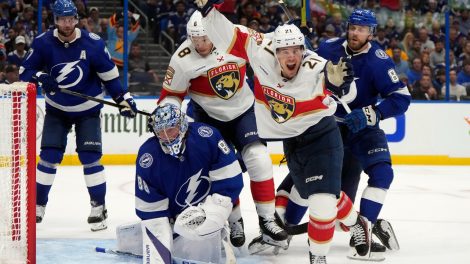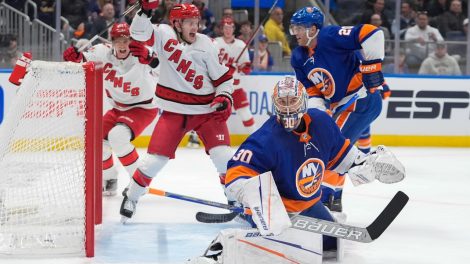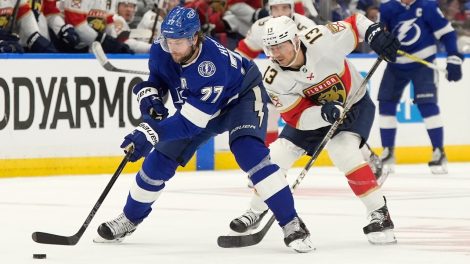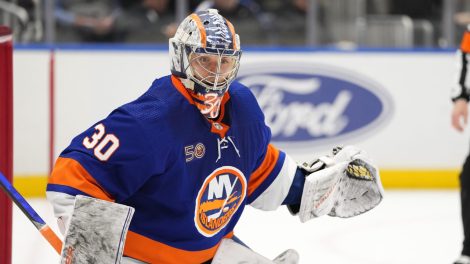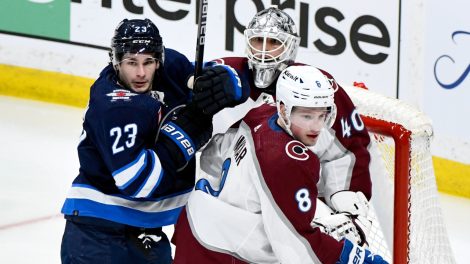Each week, Justin Bourne’s column will cover three different topics in varying depths. Think of it as a three-course meal with an appetizer, main course, and dessert…
Appetizer: Faceoffs used to be weird, have changed, and there’s no reason they couldn’t change for the better again
This week I enjoyed a laugh courtesy a tweet from Leafs assistant coach Andrew Brewer, who reminded us of an NHL oddity that seems from light years ago, but was actually just removed from the routine before the 2007-08 season.
Remember when they used to just drop the puck all over the ice?? Might be one of the most different things going back and watching old games pic.twitter.com/e5wRrhSHvf
— Andrew Brewer (@Abrew2014) June 9, 2020
I, for one, absolutely remember. Linesmen used to see where the puck was shot from before it went out of play, gesture vaguely to some area of the ice and be like “I’m gonna drop it here fellas.” Sometimes they’d point, often they’d spike their heel into a spot on the ice to represent the “dot,” but it was always kind of vague. It meant that occasionally they’d drop the puck like four feet inside the offensive zone, so it was just a battle between two centres trying to shoot the puck forward. Regardless of spot, it was a regular source of argument, with constant bickering over the location of the original shot.
It turns out, you’re allowed to change the rules when something is causing problems or can be improved. So along that line of thinking, a simple proposal that only seems radical because we haven’t already been doing it: kill neutral zone faceoffs (outside the ones at centre that start periods, come after goals, or are rectifying missed calls). They’re no good for the game.
In my two seasons doing video work for the Toronto Marlies I became fixated on the concept of “neutral zone swirl.” When you’re tagging plays by watching game action, you’re identifying game state by hitting keys on a computer (sorting for future viewing). You hit corresponding keys for breakouts, zone entries, shots, regroups, and on and on. When you hit “neutral zone forecheck,” the other team is generally in a regroup. It’s very common that after hitting “NZFC,” you follow it up with “regroup” (as you’ve disrupted their regroup). And the most common after your “regroup” is “NZFC.” And … well you get it. Clean plays are rare when 10 skaters get clustered into the middle of the rink.
[snippet id=4167285]
Neutral zone hockey results in half a shift of ping pong once that swirl gets started, and that’s exactly what neutral zone draws promote. The winning team starts a regroup and hockey is played between the blue lines with no prolonged possession for either team.
So, bring all the draws to the end-zones. For one, it penalizes offsides more. Go offside, and we’re bringing the puck all the way back to your own end. Guess what that will do? Make players more cautious at the blue line, go offside less, and we’ll have fewer whistles.
Not to mention, around 20 per cent of O-zone faceoffs result in a slot shot for. If we kill 20 neutral zone ping pong draws in favour of 20 more O-zone draws, quick math…we’d be looking at promoting offence in the game.
As fun as draws at arbitrary non-dot locations were, they’re a reminder that the game still holds some small tweaks that can make it more fun and exciting for fans.
[relatedlinks]
Main Course: When you imply “It doesn’t matter who a team’s post-season opponent is” you declare yourself legally insane
On Thursday’s Lead Off with Scott MacArthur and Mike Zigomanis, Vincent Damphousse told a story about having won a playoff series with the 1993 Canadiens, and the ensuing wait to find out who their conference final opponent was going to be. The New York Islanders and the two-time defending Stanley Cup champion Pittsburgh Penguins were going seven games to see who would move on to meet the Habs. You can imagine who Montreal was rooting for, given the Penguins’ recent history.
Damphousse talked about how, after David Volek scored the winner in overtime for the Isles, the Habs were high-fiving, excited at their improved situation given home ice and avoiding the star-laden and battle-tested Penguins.
A segment later I joined two former NHLers (Ziggy and Anthony Stewart) who then proceeded to say completely insane things. I love them both, but it’s really wonderful to have been together at SN long enough where I’m comfortable calling them out when they say insane things, because their stance was truly — did I mention this — insane. They were arguing that it doesn’t matter who you play in playoffs, at least partially because Michael Jordan used to want to beat the best opponents.
Please remember that when it comes to competition Michael Jordan himself is a competitive madman, and as such, his take on this topic is to be more or less considered null and void.
Still, the argument isn’t uncommon in sports fandom, which is why I bring it up. Were the insanity isolated I’d let it go, but you hear it every season, and from players too. We hear people who somehow believe “It doesn’t matter who you play, you have to beat everyone” (note: you don’t). Or you want to beat everyone (sure), or if you’re not good enough to beat everyone you don’t deserve the championship (lunacy), or whatever your particular brand of this line of thinking is.
Of course it matters who you play, you maniacs. It’s why the debate of post-season brackets versus seeding is so important. If Boston drew Tampa in Round 2 last year after going seven with the Leafs, would they have made it through Round 2 in six games? Maybe! But their odds of beating Columbus were undeniably better, and I’m guessing not a soul in black and gold felt deprived of the opportunity to “beat the best” or whatever.
But I really don’t want to get bogged down in one example, so please, feel as you do about the Boston/Tampa thing, but let’s move our focus back to the big picture.
Certain styles match up well against certain opponents. That’s a fact and not up for debate. A high-flying offensive team might light up opponents with defensive weaknesses, but struggle against more stingy teams. Is it possible that a high-flying offensive team could draw — by pure chance — two, three, or four teams with defensive shortcomings in a single post-season? Absolutely it’s possible. To a flawed team that succeeds one way, who they draw can be the difference between what’s seen as a successful season or not. Even just that first round draw — and the difference between a win and a loss based on playing styles — can shape the narratives of individual people and careers.
There are teams that can play it any way you want, and in the big picture, those are the teams that have sustained success. The Cup-winning Bruins and Blackhawks in particular seemed versatile and had success over prolonged periods because of it. But the most recent Cup-winning Penguins team was a little more one-dimensional (an offensive juggernaut that was in the bottom half of the league in goals against) and I think you can make the case that for a group like that, drawing opponents that allowed their strengths to shine was crucial to having success. They squeaked by, but struggled against a Capitals team that could score, and probably caught decent bounces after that by facing an Ottawa team that was 22nd in the league in goals for, and a Nashville team that sat outside the top-10 in that category.
If I ask you about the paths that were taken to winning the Stanley Cup by the 2013 Blackhawks, 2016 Penguins or 2018 Capitals, how many of you could name all four opponents each team faced? How about if we go back to the champions of 2008, or 2006, or earlier? That part of the journey fades away, because we all understand that to beat four teams in best-of-sevens, whoever it was, a team had to play unbelievably well for a long time and would be deserving of the Cup, however they got there. There are very few instances where we care who a team went through to reach the summit (save for examples like Washington finally slaying that Pittsburgh dragon).
This all seems like it’s going to be wildly relevant with the NHL’s all-new playoff format this season, doesn’t it? The top-four seeds are going to get scrambled and teams will get re-seeded as they go. Some teams are going to get dream stylistic matchups, which means others will draw nightmares. With all the moving parts for teams in the coming months, the draw will be as important as any other detail.
In the end, who you beat to win your Cup fades away. You don’t get a Cup and a half for drawing the toughest opponents. So with that I say death to “It doesn’t matter who you play.” It’s faux-bravado from a nonsense position. (Still love ya though, Stewy, Ziggy.)
[snippet id=3816507]
Dessert: The sweetest of all
Sound the alarms, blow the bugles. If this tweet isn’t the sweetest, most delicious Thursday Three Course-capper ever served up, I don’t know what is.
Granted, we still need this dessert to actually get served next month, but knowing what’s on the menu here, you’d be forgiven if you started salivating a little.

